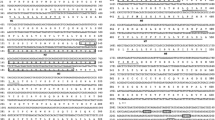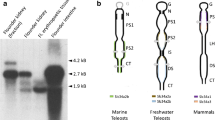Abstract
Phosphorus (P) excreted from aquaculture systems pollutes aquatic environment. Reducing P output requires reducing P input in the feeds. Reducing P in feeds, however, increases the risk of P deficiency in fish. Thus, diagnosis of P deficiency in fish will be important to avoid chronic P deficiency. To detect incipient P deficiency, a sensitive method is needed. Previously, in trout, inorganic P transporters (NaPi) in the intestine have been shown to respond rapidly to early P deficiency. For other fishes, however, little is known about the NaPi sequences, not to mention their dietary responses. In this study, intestinal NaPi sequences were isolated anew in 23 fish species, including major aquaculture species. Also, NaPi-like sequences were isolated from three molluscan species. Phylogenetic analysis of the NaPi sequences showed reasonable agreement with known evolutionary relationships. Tissue distribution of NaPi messenger RNA (mRNA) was studied in rainbow trout, crucian carp, and tilapia by real-time reverse-transcription polymerase chain reaction (RT-PCR), which revealed distribution of NaPi mRNA in several tissues other than the intestine. Acute, but not chronic, dietary P restriction increased (P = 0.01) NaPi mRNA abundance by twofold in crucian carp intestine.




Similar content being viewed by others
References
Correll DL (1999) Phosphorus: a rate limiting nutrient in surface waters. Poult Sci 78:674–682
Cho CY, Bureau DP (2001) A review of diet formulation strategies and feeding systems to reduce excretory and feed wastes in aquaculture. Aquac Res 32:349–360
Sugiura SH, Marchant D, Kelsey K, Wiggins T, Ferraris RP (2006) Effluent profile of commercially used low-phosphorus fish feeds. Environ Pollut 140:95–101
Ueda N (2007) Fish meal and aquaculture feeds statistics (in Japanese). Aquac Mag 558:26–28
FAO (2007) State of world fisheries and aquaculture 2006. Fisheries and aquaculture department, food and agriculture organization of the United Nations, Rome
Sugiura SH, Hardy RW (2000) Environmentally friendly feeds. In: Stickney RR (ed) Encyclopedia of aquaculture. Wiley, New York, pp 299–310
Sugiura SH, Ferraris RP (2004) Dietary phosphorus-responsive genes in the intestine, pyloric caeca and kidney of rainbow trout. Am J Physiol 287:R541–R550
Sugiura SH, Kelsey K, Ferraris RP (2007) Molecular and conventional responses of large rainbow trout to dietary phosphorus restriction. J Comp Physiol [B] 177:461–472
Werner A, Kinne RK (2001) Evolution of the Na-Pi cotransport systems. Am J Physiol 280:R301–R312
Sugiura SH, Dong FM, Hardy RW (2000) A new approach to estimating the minimum dietary requirement of phosphorus for large rainbow trout based on non-fecal excretions of phosphorus and nitrogen. J Nutr 130:865–872
Graham C, Nalbant P, Scholermann B, Hentschel H, Kinne RK, Werner A (2003) Characterization of a type IIb sodium-phosphate cotransporter from zebrafish (Danio rerio) kidney. Am J Physiol 284:F727–F736
Nalbant P, Boehmer C, Dehmelt L, Wehner F, Werner A (1999) Functional characterization of a Na+-phosphate cotransporter (NaPi-II) from zebrafish and identification of related transcripts. J Physiol 520:79–89
Sugiura SH, McDaniel NK, Ferraris RP (2003) In vivo fractional Pi absorption and NaPi-II mRNA expression in rainbow trout are upregulated by dietary P restriction. Am J Physiol 285:R770–R781
Huber K, Walter C, Schroder B, Breves G (2002) Phosphate transport in the duodenum and jejunum of goats and its adaptation by dietary phosphate and calcium. Am J Physiol 283:R296–R302
Radanovic T, Wagner CA, Murer H, Biber J (2005) Regulation of intestinal phosphate transport. I. Segmental expression and adaptation to low-P(i) diet of the type IIb Na+-Pi cotransporter in mouse small intestine. Am J Physiol 288:G496–G500
Marks J, Srai SK, Biber J, Murer H, Unwin RJ, Debnam ES (2006) Intestinal phosphate absorption and the effect of vitamin D: a comparison of rats with mice. Exp Physiol 91:531–537
Hilfiker H, Hattenhauer O, Traebert M, Forster I, Murer H, Biber J (1998) Characterization of a murine type II sodium-phosphate cotransporter expressed in mammalian small intestine. Proc Natl Acad Sci USA 95:14564–14569
Xu H, Bai L, Collins JF, Ghishan FK (1999) Molecular cloning, functional characterization, tissue distribution, and chromosomal localization of a human, small intestinal sodium-phosphate (Na+-Pi) transporter (SLC34A2). Genomics 62:281–284
Feild JA, Zhang L, Brun KA, Brooks DP, Edwards RM (1999) Cloning and functional characterization of a sodium-dependent phosphate transporter expressed in human lung and small intestine. Biochem Biophys Res Commun 258:578–582
Møbjerg N, Werner A, Hansen SM, Novak I (2007) Physiological and molecular mechanisms of inorganic phosphate handling in the toad Bufo bufo. Eur J Physiol 454:101–113
Werner A, Murer H, Kinne RK (1994) Cloning and expression of a renal Na-Pi cotransport system from flounder. Am J Physiol 267:F311–F317
Kohl B, Herter P, Hulseweh B, Elger M, Hentschel H, Kinne RK, Werner A (1996) Na-Pi cotransport in flounder: same transport system in kidney and intestine. Am J Physiol 270:F937–F944
Coloso RM, King K, Fletcher JW, Weis P, Werner A, Ferraris RP (2003) Dietary P regulates phosphate transporter expression, phosphatase activity, and effluent P partitioning in trout culture. J Comp Physiol [B] 173:519–530
Hattenhauer O, Traebert M, Murer H, Biber J (1999) Regulation of small intestinal Na-Pi type IIb cotransporter by dietary phosphate intake. Am J Physiol 277:G756–G762
Acknowledgments
This study was partly supported by the Grants-in-Aid program of the Japanese Society for the Promotion of Science (JSPS).
Author information
Authors and Affiliations
Corresponding author
Rights and permissions
About this article
Cite this article
Sugiura, S. Identification of intestinal phosphate transporters in fishes and shellfishes. Fish Sci 75, 99–108 (2009). https://doi.org/10.1007/s12562-008-0013-9
Received:
Accepted:
Published:
Issue Date:
DOI: https://doi.org/10.1007/s12562-008-0013-9




